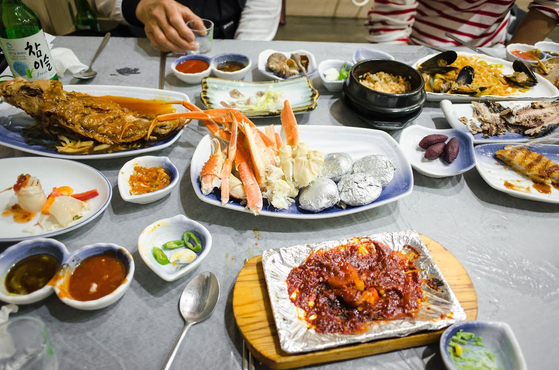Korean Cuisine: Tasting Korea’s Beauty [Photo Essay Contest]

The Korea JoongAng Daily hosted its first photo essay contest for elementary, middle and high school students on the theme: “Promote the beauty of Korea to foreign countries." The contest ran from October to November. Photos containing scenes of traditional culture, family love, places to see and tasty treats in Korea were submitted for the contest.
Katie Hong from Seoul International School won the participation prize in the middle school category for this photo essay.
Picture the aroma of sizzling kimchi wafting through the kitchen, the sound of laughter permeating throughout the house as your grandmother skillfully flips the kimchijeon (Korean pancakes). The burgeoning anticipation as you wait for the jeon to get crispy. Your grandma’s experienced hands, carefully constructing each pancake with love and care. Reminiscing the joy of eating Korean food with family contributes to warmth and nostalgia felt by many Koreans. Korea’s beauty, rather than the sky scraping buildings and modern k-culture, is its unique food.
Korea has a unique dining culture that includes the Babsang, or the Korean food table, that will occupy the center of any Korean household. The way the dishes are set reflect traditional Korean values of communal dining and a balanced harmonious meal. Korean meals are communal, so dishes are shared among all diners. A typical Korean meal consists of a bowl of rice, a bowl of soup or stew, and one or more main dishes, often accompanied by Banchan, which are side dishes served in small portions, usually ranging from kimchi, pickled vegetables, tofu, beans, or seasoned seafood. Korean main dishes are known for their exotic, bold flavors, and the use of diverse ingredients. For example, some representative Korean foods are, ganjanggaejang, samgyetang, and bunsik. Ganjanggaejang, a dish more often found in traditional meals, is a raw crab marinated in soy sauce and other seasonings. In addition, Samgyetang is a traditional Korean soup made with a whole chicken stuffed with glutinous rice, ginseng and garlic. The dish is popularly associated with nourishing and restorative properties, and is consumed during the bok season or the summer months in Korea. The belief is that consuming samgyetang during the hottest period of summer helps to replenish energy and stamina, promoting health and well-being. Bunsik, an integral part of Korean cuisine, encompasses a variety of casual snacks and light meals beloved across all age groups in Korea. Predominantly found in local eateries throughout the country, Bunsik offers an extensive array of choices. The most notable are dishes like Tteokbokki, renowned for its spicy and savory flavors, and a diverse selection of fried foods, each offering a delightful crunch and rich taste.
Korea's culinary diversity is celebrated in places like Gwangjang Market in Seoul, known for traditional street foods such as bindaetteok and bibimbap, Myeongdong's contemporary food scene with a fusion of traditional and modern street foods, and Busan's Jagalchi Market, a haven for seafood enthusiasts. These locations offer an authentic taste of Korea's culinary tradition. Some of the popular dishes you can find at Gwangjang Market include bindaetteok (mung bean pancakes), bibimbap (mixed rice), tteokbokki (spicy rice cakes), and mayak kimbap (bite-sized seaweed rice rolls). It is a cultural and culinary hub that attracts both locals and tourists, providing an authentic taste of Korean tradition. Myeongdong is the more contemporary food hub, celebrated for its diverse street food offerings. Food stalls and vendors line the streets, tempting passersby with a variety of delectable snacks. From hotteok (sweet pancakes) and odeng (fish cake skewers) to savory skewers and grilled delicacies, Myeongdong's street food showcases the fusion of traditional and modern flavors. Moreover, Jagalchi Market is a bustling and iconic fish market located in the coastal city of Busan. Known to be the largest seafood market in the country, visitors can explore a rich range of Korean seafood cuisine including a variety of fish, shellfish, octopus, abalone, and other marine delicacies.
South Korea’s beauty lies not only in its towering buildings or modern K-culture but in its unique food culture. The sizzling gimchi, the warmth of sitting with your family eating at a bapsang, the bold and unique flavors of Korean dishes all contribute to a sense of warmth and nostalgia for Koreans. Ultimately, it is in these culinary experiences that the true beauty of Korea emerges; a beauty that cannot only be seen, but tasted. The country's rich food culture serves as a powerful connection to its past, a celebration of family, tradition, and the unique variety of flavors that define Korea.
By Katie Hong, Seoul International School










with the Korea JoongAng Daily
To write comments, please log in to one of the accounts.
Standards Board Policy (0/250자)